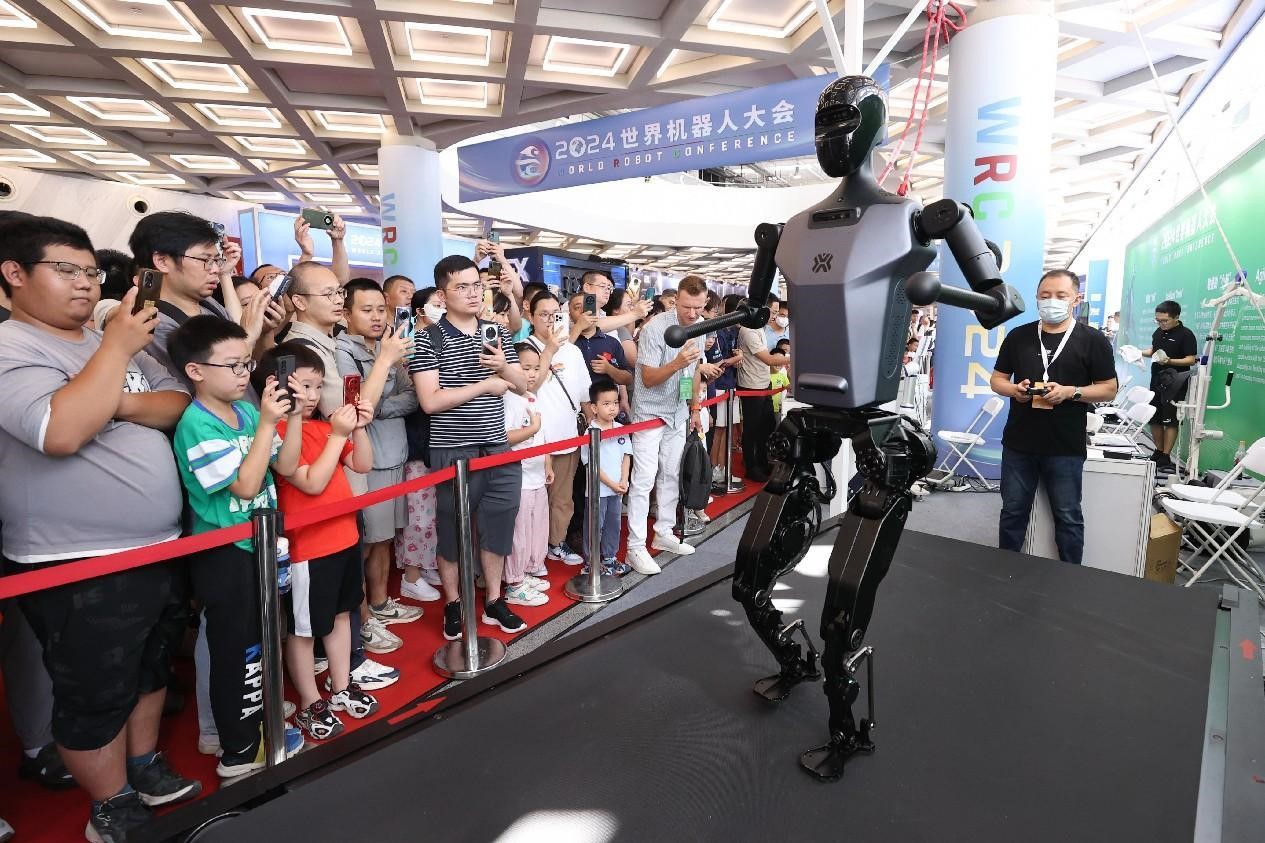Chinese robot industry strides toward high-quality development

A humanoid robot showcases its ability to run at the 2024 World Robot Conference held in Beijing, August 22, 2024. (Photo by Chen Xiaogen/People's Daily Online)
The 2024 World Robot Conference was recently held in Beijing. Nearly 170 Chinese and foreign robot enterprises joined the 2024 World Robot Expo, part of the World Robot Conference, unveiling more than 600 innovative products, including 27 humanoid robots.
In recent years, the Chinese robot industry has experienced rapid growth, integrating deeply into people's daily work and life. China has become the world's largest market and producer of robots.
Recently, humanoid robot Walker S Lite developed by UBTECH Robotics Corp., Ltd., a leading robotics firm based in Shenzhen, south China's Guangdong Province, completed training at the 5G smart factory of Chinese electric vehicle brand Zeekr in Ningbo, east China's Zhejiang province, after working three weeks alongside its human counterparts. With a maximum load of 15 kilograms, it can assist workers in carrying work bins.
According to Zhao Chunlin, head of the 5G smart factory, Walker S Lite has become the first humanoid robot in China to perform the entire process of moving cargo boxes, showcasing exceptional task completion and difficulty levels that ranked at the forefront of the industry.
To meet the growing individualized demands, the Chinese manufacturing industry is transitioning from high automation to comprehensive intelligentization.
"Humanoid robots enabled by artificial intelligence (AI) possess multimodal perception and autonomous decision-making capabilities. They have a competitive advantage when facing complex and changing work environments, showing great potential and broad prospects in intelligent manufacturing," Zhao noted.

A child plays Go with an artificial intelligence (AI) robot at the 2024 World Robot Conference. (Photo by Chen Xiaogen/People's Daily Online)
According to the latest statistics from China's Ministry of Industry and Information Technology, the country's newly added robot installations accounted for more than half of the global market over the past three years, and the number of robots per 10,000 workers in China's manufacturing sector reached 470, surging 19 fold in the past decade.
Service robots have been widely applied in areas such as family services and medical care, while specialized robots play a crucial role in areas such as air and sea exploration and emergency rescue.
Apart from the growing size, China's robot industry has seen a continuous increase in technological capabilities, marked by constant breakthroughs in cutting-edge technologies such as multi-sensor fusion perception and natural human-machine interaction, increasingly sophisticated key components like reducers, controllers, and servo systems, and enhanced performance and safety levels of industrial robots engaged in welding and spraying and service robots for surgery and logistics. As of July 2024, China boasted over 190,000 effective robot-related patents, accounting for about two-thirds of the global total.
At the same time, governance and regulation of China's robot industry are becoming increasingly comprehensive. The Chinese government has implemented effective policies and measures, such as a development plan for the robotics industry, a "Robot +" action plan, and industry norms for industrial robots.
China has participated in the revision of 26 international robot standards, established the World Robot Cooperation Organization, issued the Shanghai Declaration on Global AI Governance, and promoted international cooperation in robot ethics research, regulation and governance.
At the opening ceremony of the 2024 World Robot Conference, the upgraded TianGong 1.2MAX humanoid robot was unveiled by the Beijing Embodied Artificial Intelligence Robotics Innovation Center, China's first innovation center focused on core technologies, product development and application ecosystems for humanoid robots.
Standing 173 centimeters tall and weighing 60 kilograms, the robot featured 42 degrees of freedom. It carried the emblem of the conference and placed it precisely on a launch pad in the center of the stage. This marked the first time that a humanoid robot demonstrated long-range task capabilities.
"TianGong 1.2MAX is equipped with multiple visual perception sensors, six-dimensional force sensors, an inertial measurement unit, and 3D vision sensors, which allow it to perform 550 trillion calculations per second," said Xiong Youjun, the center's general manager.
Twenty-seven humanoid robots made their debut at the 2024 World Robot Conference, attracting considerable attention. When will these products be available for mass production?
"The humanoid robot G1, launched in May this year with a starting price of 99,000 yuan ($13,922), is close to completing the design modifications for mass production, and is expected to be mass-produced by the end of the year," said Wang Xingxing, founder, chief executive officer, and chief financial officer of Unitree Robotics, a Hangzhou-based robotics startup.
The application of large language models and multimodal models is accelerating the evolution of humanoid robots, but a general-purpose large model is necessary for these robots to be integrated into industrial and services sectors, Wang explained. "I am optimistic and believe that this time frame will not exceed 5 years."
"If we follow the order of development, the primary areas where humanoid robots may be first deployed are production lines and special positions such as inspection and maintenance, followed by household chores, elderly care, and other services scenarios," said Ren Lei, co-founder of a Chinese humanoid robot developer and a professor at Jilin University.
Wang He, assistant professor in the Center on Frontiers of Computing Studies (CFCS) at Peking University (PKU) and head of PKU-Galbot Joint Lab of Embodied AI, predicted that the ability of humanoid robots to grasp, position, and move can be utilized in multiple scenarios such as factories, retail, and services sector, with the potential to achieve rapid growth from hundreds to thousands of units in the next two years. "In the next 15 years, humanoid robots will definitely grow into a trillion-yuan market," he said.

Robotic arms weld a car frame at the 2024 World Robot Conference. (Photo by Chen Xiaogen/People's Daily Online)
Photos
Related Stories
- Experience China in 144 hours | Tangshan, world of robots
- China's humanoid robots advance with enhanced emotional interaction
- AI-powered robots steal the show at World Robot Conference in Beijing
- Chinese premier calls for strengthening global cooperation to boost robot industry
- Made-in-China robots venturing out from labs to daily life
- China remains world's largest industrial robot market
- China's humanoid robots race ahead in global industry
- Humanoid robots put on eye-watching display at World Robot Conference in Beijing, showcasing China’s cutting-edge robotics prowess
- World Robot Conference 2024 opens in Beijing
- Beijing E-Town vigorously promotes development of humanoid robot industry
Copyright © 2024 People's Daily Online. All Rights Reserved.









